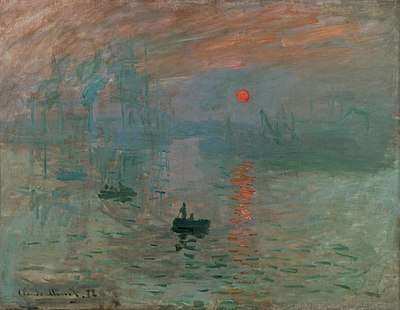Laura Muntz Lyall
Laura Muntz Lyall (Leamington Spa, Warwickshire, June 18, 1860 – Toronto December 9, 1930) was a Canadian Impressionist painter, known for her portrayal of women and children.[1]
Laura Muntz Lyall | |
|---|---|
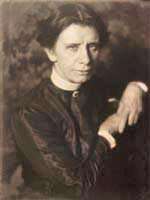 | |
| Born | Laura Adeline Muntz June 18, 1860 Leamington Spa, Warwickshire, United Kingdom |
| Died | December 9, 1930 (aged 70) Toronto, Ontario, Canada |
| Nationality | Canadian |
| Education | Ontario School of Art, Académie Colarossi |
| Known for | Painting |
| Movement | Impressionism |
| Spouse(s) | Charles W.B. Lyall |
Life and work
Laura Adeline Muntz was born at Leamington Spa, Warwickshire, England in 1860, but her family emigrated to Canada when she was a child.[2][3] She grew up on a farm in the Muskoka District of Ontario.[4] As a young woman, Muntz`s interest in art led to her take lessons in painting from William Charles Forster of Hamilton and to live and work at his school.[4][5] Starting in 1882, she began to take classes at the Ontario School of Art where she studied with Lucius Richard O'Brien, and later under George Agnew Reid.[5] She studied briefly at the South Kensington School of Art in 1887, then returned to Canada to continue her studies with Reid.[4] In 1891, she embarked on a seven-year period of study in Paris, attending the renowned Académie Colarossi. Her preferred subject was children.[6] From 1893 on, her handling of paint was impressionist.[6] Her work was exhibited in various exhibitions, resulting in some works being reproduced in periodicals, growing prestige and successful sales.[6]
To stretch her limited financial resources, she gave private English lessons, and shared an apartment with the American painter, Wilhelmina Hawley (1860-1958).[7] Hawley likely taught Muntz her watercolour technique,[8] and they travelled together to Rijsoord in the southern Netherlands where they painted.[8] In 1896, at the Académie Colarossi, in recognition of her diligence and talent, Muntz was made massière or studio head.[9]
On her return to Canada in 1898, she set up a studio in Toronto and began to teach and paint.[4] In the decade at the beginning of the new century, she was said to be the artist with the greatest versatility among women painters because she painted such a wide variety of subjects.[10] When, in 1906, she moved to Montreal to continue her career at 6 Beaver Hall Square, she reached a sizable new audience that regarded her as the premier Canadian portraitist of children.[11]
Her work received recognition both in Canada and beyond. Muntz exhibited her work at the Palace of Fine Arts at the 1893 World's Columbian Exposition in Chicago, Illinois,[12] and then in 1894 as part of the Société des Artistes Français in Paris. She continued to exhibit at many international exhibitions following her return from Paris, and her work was recognized with a silver medal at the 1901 Pan-American Exposition.[4] She was subsequently awarded a bronze medal at the 1904 St Louis World Fair Exposition.[4][5] She showed 27 paintings with the Royal Canadian Academy of Arts between 1893 and 1929.[4] Her work was frequently compared and contrasted with that of her contemporary and friend Florence Carlyle.[4][13]Both the National Gallery of Canada and the Art Gallery of Ontario include her works in their holdings.[1]
She was elected as an associate member of the Royal Canadian Academy of Arts[14] in 1896, only the eighth woman to receive this honour.[4] Muntz was a member of the Ontario Society of Artists starting in 1891; she was the first woman appointed to its Executive Council in 1899, serving until 1903.[4] In 1909, she became a member, the only woman, of the Canadian Art Club.[11]
Following the death of her sister in 1915, she returned to Toronto and married her brother-in-law Charles W.B. Lyall to care for the children of her sister's marriage (there were 11 of them but only a few remained at home). She then set a studio up in the attic of their home, and started signing her works with her married name.[5] In 1921, she travelled with her husband to Devon, England and there painted what was new scenery for her. Critics praise her handling of light and restrained though rich colour, proof that she could have been a major landscape painter if she chose.[15]
In 1930, Muntz was ill and dying of Exophthalmic Goitre brought on partly by overwork and worry about the family responsibilities she had assumed fifteen years earlier.[16] Despite these trying personal circumstances, she continued to paint until her death in 1930.[5]
Lyall is interred in the Mount Pleasant Cemetery in Toronto.[17]
Paintings
 Oriental Poppies
Oriental Poppies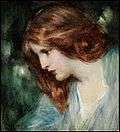 Portrait of a young woman
Portrait of a young woman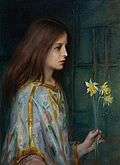 Young girl holding daffodils
Young girl holding daffodils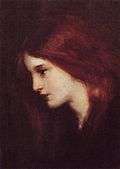 The little red hair
The little red hair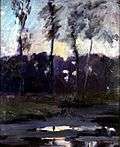 Trees by the river (1900)
Trees by the river (1900) Interesting Story (1898)
Interesting Story (1898)
References
- "LYALL, Laura Muntz". Canadian Women Artists History Initiative. Concordia University. Retrieved September 27, 2013.
- Murray 2012, p. 133.
- Farr, Dorothy; Luckyj, Natalie (1975). From Women's Eyes: Women Painters in Canada. Kingston: Agnes Etherington Art Centre. p. 28.
- Gualtieri, Julia (1989). The Woman as Artist and as Subject in Canadian Painting. Kingston, Ontario: Queen's University. pp. 145–146, 155–161.
- Prakash, A.K. (2008). Independent Spirit: Early Canadian Women Artists. Buffalo, New York: Firefly Books. pp. 265–268. ISBN 1554074177.
- Murray 2012, p. 19.
- Murray 2012, p. 19-21.
- Murray 2012, p. 22.
- Murray 2012, p. 24.
- Murray 2012, p. 35.
- Murray 2012, p. 39.
- Nichols, K. L. "Women's Art at the World's Columbian Fair & Exposition, Chicago 1893". Retrieved July 24, 2018.
- Murray 2012, p. 37-8.
- "Members since 1880". Royal Canadian Academy of Arts. Retrieved March 8, 2015.
- Murray 2012, p. 46.
- Murray 2012, p. 48.
- Find A Grave, Laura Muntz Lyall
Bibliography
- Murray, Joan (2012). Laura Muntz Lyall: Impressions of Women and Childhood. Montreal, Quebec: Boardwalk Ventures Inc. by McGill Queen's University Press. ISBN 978-0-7735-4098-9.CS1 maint: ref=harv (link)
Further reading
- Prakash, A.K. Impressionism in Canada: A Journey of Rediscovery. Stuttgart: Arnoldsche Art Publishers, 2015, pp. 418-437. ISBN 978-3-89790-427-9
External links
| Wikimedia Commons has media related to Laura Muntz Lyall. |
